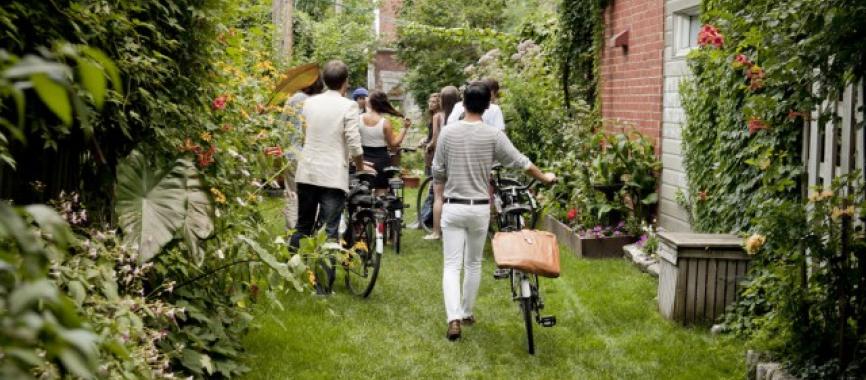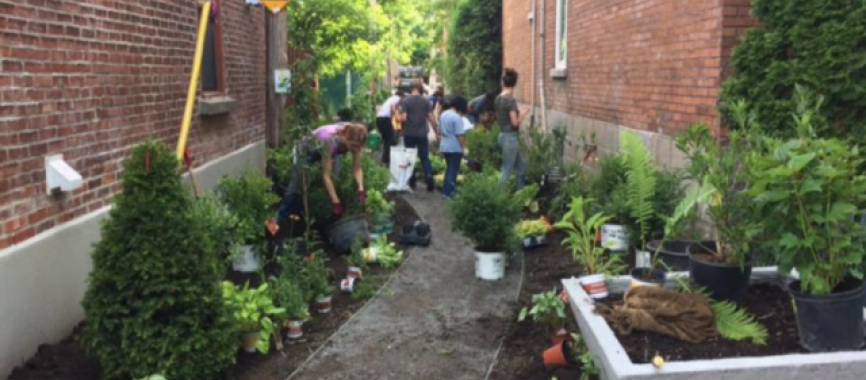What Toronto Can Learn from Montreal’s Green Laneways
As Toronto investigates the possibilities of laneway housing, Montreal is already a leader in another approach to encouraging creative uses of the spaces behind and between buildings.
If you turn down any alleyway in a residential neighbourhood of Montreal, you may find potted plants, strategically-placed seating, and perhaps a sign saying “ruelle verte.” There are 346 of these “green laneways” throughout the city.
According to Regroupement des éco-quartiers, an umbrella organization for neighbourhood-based environmental initiatives, there are several defining features of a ruelle verte. First, it’s a community-driven endeavour led by a committee of people living or working near a laneway. Second, changes to a laneway aim to improve environmental conditions but also introduce opportunities for neighbours to come together.
To date, 69 kilometres of laneways have been transformed by benches, bike parking, and flower beds in 11 of the city’s 19 boroughs. If connected, these green laneways would be almost as long as the Montreal Metro. But with 475 kilometres of laneways in the city, there’s ample room for other residents to adopt the approach. The same could be said of Toronto, where 2,400 laneways span 300 kilometres.
The Laneway Project is a social enterprise focused on transforming Toronto’s laneways. Co-founder and director Michelle Senayah says greening laneways “seems like an obvious opportunity.”
Toronto’s laneways are concentrated in older parts of the city, where they facilitated deliveries by horse and cart, as well as other service functions. Research by the Laneway Project and other groups suggests that these areas are often underserved by parks compared to other parts of the city. Senayah explains: “When you look at where laneways are and where parks are, there’s actually something of an inverse relationship.”
In this context, laneways can play a role both environmentally and socially. The Laneway Project has produced a guide to greening laneways, which outlines several strategies to introduce plants of all shapes and sizes between garages or behind stores.
From an environmental perspective, small changes to laneways can enhance biodiversity and reduce the urban heat island effect. Representing approximately 200,000 square metres of paved surfaces, laneways can also be adapted to improve storm water management. Senayah describes the Laneway Project’s puncture demonstration as “a meter-wide ribbon of green.” The permeable pavers not only reduce runoff but also add playful patterns to areas that are often overlooked.
ocially, laneways are an opportunity for neighbours to come together and take responsibility for shared spaces. This approach is central to the success of Montreal’s ruelles vertes, where local committees manage each laneway.
The borough of Rosemont–La Petite-Patrie has the most extensive network of ruelles vertes in the city. Since 2011, 98 laneways have been transformed into gathering places that incorporate countless container gardens, 50-plus murals, and two dozen benches.
According to Senayah, neighbourhood involvement is “how these projects live beyond their installation.” From making sure seating is in good shape to weeding raised beds, care and attention on the part of people who pass through laneways on a daily basis is essential.
As experiences from Montreal show, residents can turn local knowledge into site-specific solutions that lower the ambient temperature, welcome urban wildlife, provide a canvas for artists and invite neighbours to get to know one another.
In Toronto, the potential to turn laneways into green spaces is all the more pressing because our back alleys may soon become the front yards of a new generation of secondary suites.
Read original article @ Torontoist






